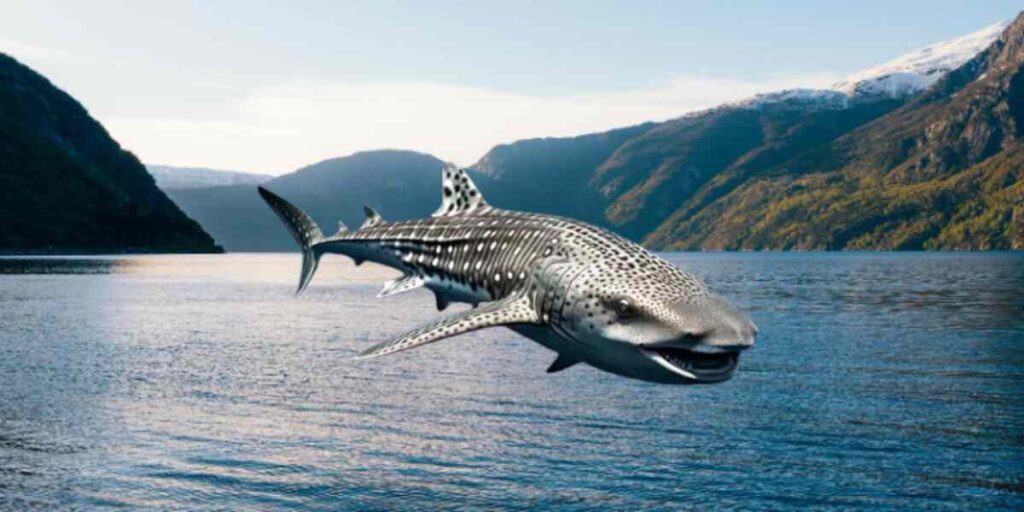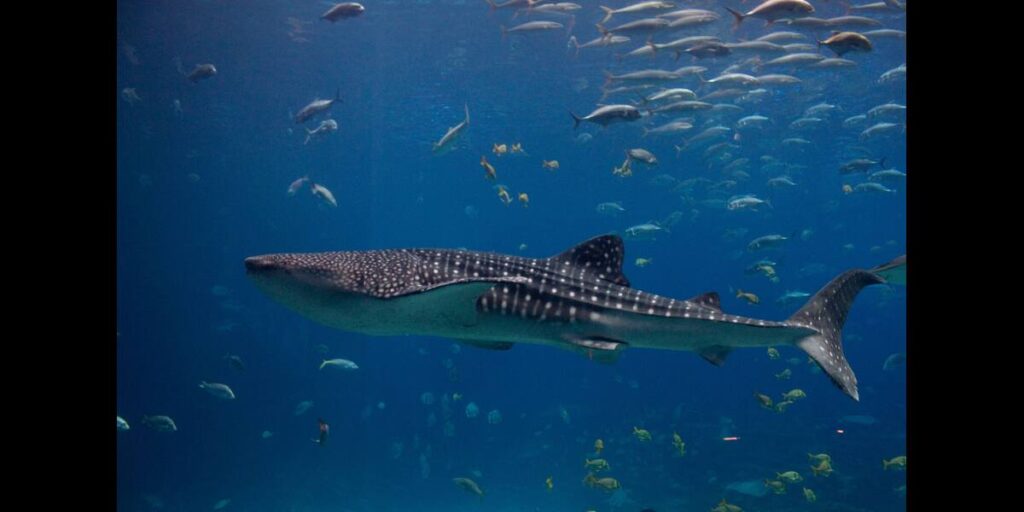Whale sharks are the largest fish in the ocean. Compared to humans, they are enormous. An average whale shark is about 40 feet long, while an average human is only about 5.5 feet tall.
Imagine swimming next to a creature as big as a school bus. Your heart races as you see its massive spotted body glide by. This gentle giant dwarfs you yet moves with surprising grace through the water.
They eat tiny plankton, not people. They are harmless to humans despite their size. Many divers swim with whale sharks to admire their beauty. It’s a chance to feel small beside one of nature’s most impressive animals.
Whale Shark Size
Whale sharks (Rhincodon typus) are the largest living fish in the ocean. They typically grow to about 40 feet (12 meters) long, but some can reach up to 60 feet (18 meters). Their size makes them truly impressive and easy to spot in the water. As gigantic fish with immense dimensions, Rhincodon typus stand out significantly in their marine environments.
In terms of weight, this Shark can weigh up to 20,000 pounds (9,000 kilograms). The largest ones have been known to weigh as much as 30,000 pounds (13,600 kilograms). This makes them significantly heavier than most other fish species. Their sheer size and weight make them an awe-inspiring presence in the oceans, whether in the Indian Ocean, Pacific, or Atlantic Ocean.
To give you an idea of their size compared to humans, a Rhincodon typus is more than seven times longer and over 100 times heavier than the average person. Imagine a Rhincodon typus being as long as a school bus and heavier than a fully loaded truck! Among marine animals, whale sharks are the largest fish species, though they are smaller than some of the largest whales like the blue whale. Their massive size contributes to their unique and awe-inspiring presence in the ocean.
Whale Shark Compared to Human
When you compare a Rhincodon typus to a human, the size difference is astounding. These sharks are giants of the ocean, often reaching lengths of about 40 feet (12 meters). In contrast, the average human is only about 5.6 feet (1.7 meters) tall. This makes a Rhincodon typus more than seven times longer than a person.
In terms of weight, Rhincodon typus are incredibly heavy. They can weigh up to 20,000 pounds (9,000 kilograms). This is over 145 times heavier than the average human, who weighs around 137 pounds (62 kilograms). The weight difference is so great that a Rhincodon typus is like a fully loaded truck compared to a person.
Seeing a Rhincodon typus next to a human puts their size into perspective. If you were standing next to one, you’d be tiny in comparison. A Rhincodon typus’s massive size emphasizes the incredible diversity of life in our oceans.
Average Height and Weight of a Human
The average height of an adult human varies by gender and region. In the United States, adult men typically stand about 5 feet 9 inches (175.3 cm) tall, while adult women average around 5 feet 4 inches (162.6 cm). This height difference is a common characteristic between genders and can vary slightly based on factors like genetics and nutrition.
Weight also varies among adults, with average weights differing between men and women. In the U.S., the average weight for adult men is approximately 197.9 pounds (89.8 kg), whereas for women, it is about 170.6 pounds (77.4 kg). These averages reflect a range of body types and can be influenced by lifestyle, diet, and overall health.
Comparison to the Size of a Whale Shark
A whale shark’s size compared to a human is strikingly different. Rhincodon typus can grow up to 40 feet (12 meters) long, making them one of the largest living fish in the ocean. In contrast, the average human is only about 5.6 feet (1.7 meters) tall. This means a Rhincodon typus is more than seven times longer than a typical person, highlighting the enormous size of these marine giants.
In terms of weight, whale sharks are equally impressive. They can weigh up to 20,000 pounds (9,000 kilograms), which is over 145 times heavier than the average human, who weighs about 137 pounds (62 kilograms). This immense weight makes the Rhincodon typus much bulkier and more substantial compared to any human.
Visualizing the size difference between a Rhincodon typus and a human can be quite dramatic. If a human stood next to a whale shark, the shark would dwarf them significantly. This comparison not only showcases the Rhincodon typus’s massive scale but also emphasizes the incredible diversity of marine life.
Visual Representation of the Size Difference

To truly grasp the size difference between a whale shark and a human, consider a visual comparison. Imagine a whale shark swimming next to a human. The Rhincodon typus, reaching up to 40 feet (12 meters) in length, would be much longer than a human standing next to it. The human, with an average height of about 5.6 feet (1.7 meters), would look tiny beside this enormous fish.
In terms of weight, the visual impact is even more striking. A whale shark can weigh up to 20,000 pounds (9,000 kilograms), which is dramatically heavier than the average human’s weight of around 137 pounds (62 kilograms). Picture a fully loaded truck compared to a single person. This weight difference highlights the sheer bulk of whale sharks.
Whale Shark Behavior and Characteristics
Whale sharks exhibit unique behavior and characteristics that make them fascinating to study. They are filter-feeding sharks, meaning they consume tiny organisms like plankton and small fish by swimming with their mouths wide open. This feeding method involves filtering large volumes of water through their gill slits to capture their food. This specialized feeding technique sets them apart from most other marine animals.
In addition to their feeding habits, Rhincodon typus are known for their extensive migration patterns. They travel long distances across tropical oceans and warm-temperate waters, often visiting specific aggregation sites in places like the Philippines, Mexico, and Australia. Understanding their migration helps scientists protect their habitats and ensure their survival.
Physically, whale sharks are distinguished by their large size and unique spotted patterns. Their broad, flat heads and wide mouths are adapted for their filter-feeding lifestyle. These features, along with their gentle nature, make whale sharks a popular attraction for eco-tourists and researchers. Their impressive size and distinctive markings add to their allure and highlight their importance in marine environments.
Migration Patterns and Geographical Locations
Rhincodon typus are known for their extensive migration patterns, traveling long distances across the world’s oceans. They move through tropical and warm-temperate waters, often following the availability of food sources such as plankton blooms. These migrations are essential for their survival, as they help whale sharks find the rich feeding grounds they need to thrive.
Key locations where whale sharks are frequently seen include the Philippines, Mexico, and Australia. These regions have notable aggregation sites where many Rhincodon typus gather at certain times of the year. Understanding their migration patterns and preferred geographical locations is crucial for conservation efforts, helping researchers and organizations protect these gentle giants and their habitats effectively.
Unique Physical Characteristics
Whale sharks are easily recognizable due to their unique physical features. One of their most striking characteristics is their large size. They can grow up to 40 feet (12 meters) long, making them the largest living fish in the ocean. Their enormous size is complemented by a broad, flat head and a wide mouth that helps them filter feed efficiently.
Another distinctive feature is their spotted pattern. Whale sharks have a unique arrangement of white spots and stripes on their dark gray skin. Each whale shark’s pattern is different, much like human fingerprints, making it easy for researchers to identify and track individual sharks. These spots help them blend into the ocean’s dappled light and shadow, providing camouflage from predators.
Whale sharks also have specialized structures called gill rakers inside their mouths. These filter-feeding structures help them capture tiny food particles like plankton from the water. Their gentle feeding behavior and large size make them a favorite among marine enthusiasts and researchers, highlighting their importance in marine ecosystems and emphasizing their role as gentle giants of the sea.
Whale Shark Conservation Status
Whale sharks are currently classified as “Vulnerable” by the International Union for Conservation of Nature (IUCN). This status means that they face a high risk of extinction in the wild due to various threats. Their population is decreasing, primarily due to human activities that impact their survival.
Threats to Population

Illegal Fishing: Whale sharks are targeted for their fins, meat, and oil, leading to a decline in their numbers due to illegal trade.
Ship Collisions: Large and slow-moving, whale sharks are at risk of serious injuries or death from accidental collisions with boats and ships.
Entanglement in Fishing Gear: Whale sharks can become accidentally caught in fishing nets and lines, causing injury or death.
Pollution: Contamination from plastics and chemicals affects their feeding grounds, harming their health and reducing their food sources.
Habitat Destruction: Coastal development and habitat degradation diminish the quality of the environments where whale sharks live and feed.
Conservation Efforts
Legal Protection: Laws now protect whale sharks from hunting and trade. These rules help keep them safe from capture and harm.
Marine Protected Areas: Special zones are set up to protect this habitats. These areas limit activities that could damage their feeding and migration routes.
Research and Monitoring: Scientists track this shark populations and behavior. This helps them understand what Rhincodon typus need and how to protect them.
Awareness and Education: Conservation groups spread the word about Rhincodon typus. They educate people on the importance of these animals and promote responsible tourism.
Collaboration with Local Communities: Local communities get involved in protecting whale sharks. They support conservation efforts through eco-tourism and sustainable practices.
Frequently Asked Questions
Are whale sharks aggressive?
No, whale sharks are not aggressive. They are gentle giants and pose no threat to humans.
How big do whale sharks get?
Whale sharks can grow up to 60 feet (18 meters) long and weigh as much as 30,000 pounds (13,600 kilograms).
Is a whale shark bigger than a megalodon?
No, the megalodon was larger than whale sharks. Megalodon could reach over 60 feet (18 meters), while whale sharks typically grow up to that length.
Do whale sharks eat?
Yes, whale sharks eat by filter-feeding on small organisms like plankton and tiny fish. They swim with their mouths open to capture their food.
Why can’t you touch whale sharks?
Touching whale sharks can harm their delicate skin and disrupt their natural behavior. It’s best to observe them from a distance.
Do whale shark bites hurt?
Whale shark bites do not hurt humans. Their mouths are designed for filter-feeding and are not capable of causing harm to people.
Conclusion
Whale sharks are incredible creatures that play a crucial role in our oceans. Their impressive size and unique behaviors make them fascinating to study. However, they face significant threats such as illegal fishing, pollution, and habitat destruction, which endanger their survival.
Protecting Rhincodon typus requires a combination of efforts. Legal protections, marine reserves, and ongoing research are essential for their safety, and raising awareness and involving local communities also contribute to their conservation. By supporting these measures, we can help ensure that Rhincodon typus continue to thrive and remain a vital part of our marine ecosystems.
Also Read:

